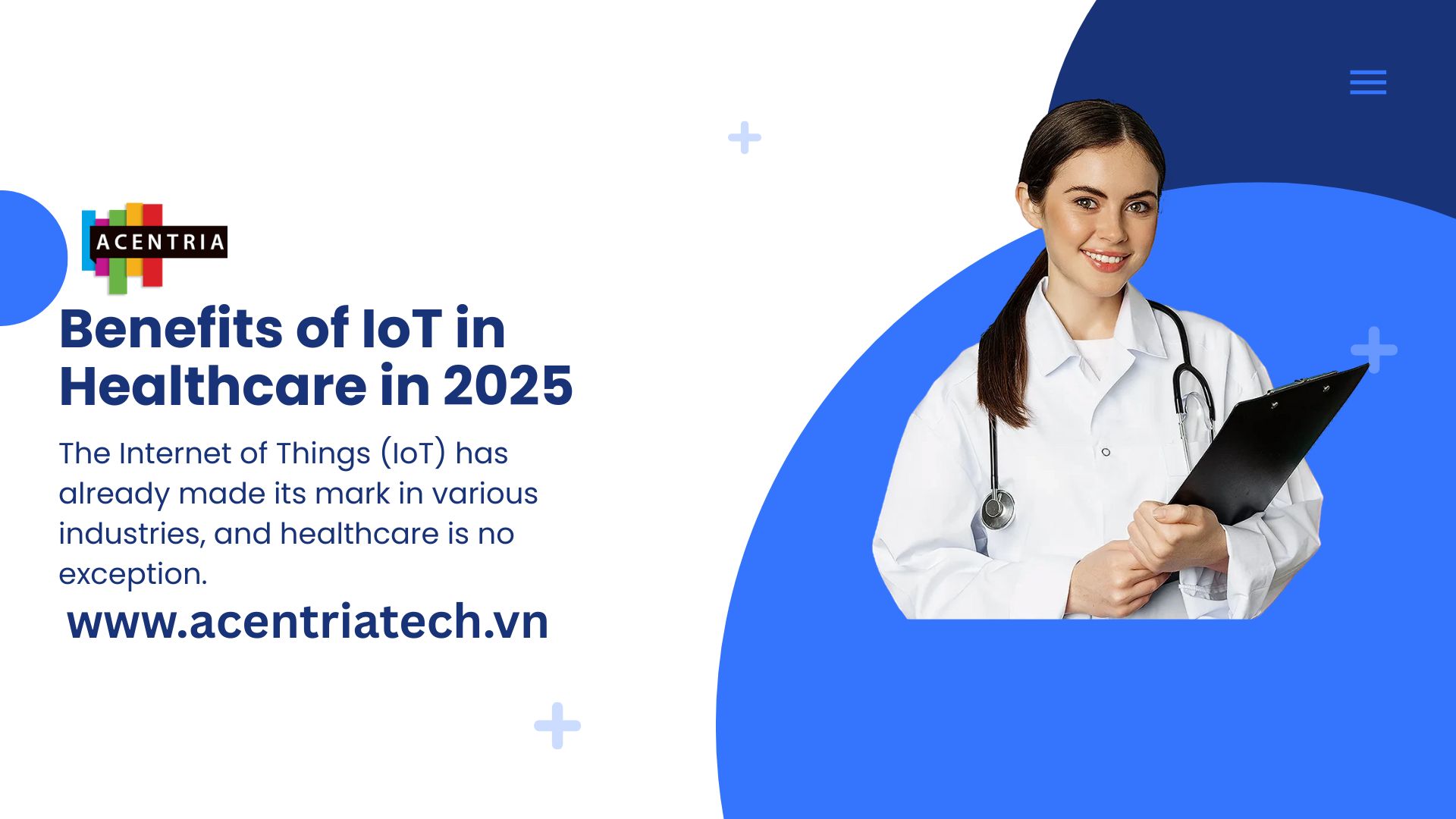Top 9 Benefits of IoT in Healthcare in 2025
The Internet of Things (IoT) has already made its mark in various industries, and healthcare is no exception. As we move into 2025, IoT is poised to revolutionize how healthcare systems operate, improving patient care, optimizing hospital workflows, and enabling real-time health insights. The integration of IoT in healthcare is not only about connected devices but also about creating a smarter and more efficient healthcare ecosystem.
In this blog, we’ll explore the top 9 benefits of IoT in healthcare in 2025, focusing on how this technology is enhancing patient outcomes, streamlining operations, and supporting a healthier, more sustainable future. From remote patient monitoring to predictive maintenance of medical equipment, IoT is paving the way for a more connected, efficient, and patient-centered healthcare environment.
1. Enhanced Remote Patient Monitoring
One of the most Benefits of IoT in Healthcare significant advancements that IoT brings to healthcare is remote patient monitoring. With IoT-enabled devices such as wearable health trackers, remote sensors, and smart medical equipment, healthcare providers can continuously monitor patients’ vital signs and overall health status, even when they are not in a hospital setting.
In 2025, healthcare software development will likely provide more sophisticated monitoring tools that collect data from patients’ homes and transmit it to healthcare professionals in real-time. This allows for constant tracking of metrics such as heart rate, blood pressure, glucose levels, and oxygen saturation. It empowers doctors to intervene promptly if any abnormalities are detected, leading to better care management and reducing hospital readmission rates.
Moreover, these systems enable patients to take more control over their health, creating a proactive rather than reactive approach to treatment. By facilitating continuous care, IoT enables improved patient outcomes and can help reduce the burden on hospitals and healthcare facilities.
2. Smart Hospitals and Efficient Resource Management
The concept of smart hospitals is one of the most transformative aspects of IoT in healthcare. In these smart facilities, IoT-enabled systems manage a wide range of hospital resources—from patient beds and equipment to staff allocation and medication supply chains. By integrating IoT devices into the infrastructure, hospitals can optimize operations and improve overall efficiency.
For example, healthcare software solutions can track the location of medical equipment, ensuring that high-demand devices like ventilators or ECG machines are available when needed. Similarly, IoT sensors can monitor the availability and cleanliness of hospital rooms, minimizing patient wait times and streamlining the entire care process.
Additionally, IoT-based systems can analyze hospital resource usage in real-time, providing insights into how to allocate resources more effectively. This will result in better patient experiences, optimized workflows, and reduced operational costs, all of which are crucial as healthcare systems face increasing pressure to become more efficient.
3. Telemedicine Advancements
Telemedicine is already playing a significant role of Benefits of IoT in Healthcare, and with the power of IoT, it is poised to become even more sophisticated by 2025. IoT allows for more seamless and effective telehealth services by enabling real-time data sharing between patients and healthcare providers.
Healthcare development companies are integrating IoT with telemedicine platforms, allowing doctors to access live data from wearable devices, such as heart rate monitors, blood glucose meters, or even smart inhalers. This real-time data sharing makes remote consultations more precise, as healthcare providers can base their recommendations on accurate, up-to-date information.
By leveraging IoT in telemedicine, patients who live in remote areas or who are unable to visit hospitals can still receive high-quality care. This is particularly crucial for managing conditions like diabetes, hypertension, and chronic heart diseases, where constant monitoring is necessary for successful treatment.
4. Improved Chronic Disease Management
IoT’s role in chronic disease management is another key benefit that will continue to grow in importance by 2025. Chronic conditions such as diabetes, cardiovascular diseases, and asthma require constant monitoring to prevent complications. IoT technologies are enabling continuous tracking of various biomarkers and health parameters that help manage these conditions more effectively.
For instance, connected devices can monitor blood sugar levels, detect changes in heart rate, or measure lung capacity, sending alerts to both the patient and healthcare providers when irregularities occur. This data-driven approach allows doctors to adjust treatment plans in real-time and intervene before conditions worsen, leading to better long-term health outcomes.
Moreover,Benefits of IoT in Healthcare supports medication adherence by sending reminders or alerts when it’s time for the patient to take their medication. This reduces the risk of non-compliance and ensures patients are staying on track with their treatment plans.
5. Continuous Monitoring and Early Intervention
One of the most impactful benefits of IoT in healthcare is its ability to provide continuous monitoring of patients, even outside the hospital. Wearable devices and connected sensors provide a constant stream of health data, which can be analyzed for early signs of potential health issues.
For example, IoT-enabled ECG monitors can detect abnormal heart rhythms, while smart watches with heart rate monitors can alert users if they are experiencing arrhythmia. The real-time transmission of data to healthcare professionals allows for immediate intervention, potentially preventing heart attacks, strokes, or other severe conditions.
This continuous monitoring system can also help reduce hospital readmissions, as doctors can intervene before an acute episode develops. This level of preventive care enhances patient safety and significantly reduces healthcare costs by avoiding unnecessary hospital stays.
6. Quantifiable Health Improvements
With the vast amount of data collected through IoT devices, healthcare providers can obtain quantifiable health improvements that allow for more precise treatment adjustments and better tracking of progress over time. By using connected devices to collect health data over weeks, months, and even years, doctors can track trends and monitor the effectiveness of treatments.
For example, a patient with chronic heart disease might use a connected blood pressure cuff to send daily readings to their doctor. By analyzing the data over time, the healthcare provider can determine how effective a particular medication or lifestyle change has been and make more informed decisions about adjusting the treatment plan.
The ability to quantify health improvements also empowers patients, giving them tangible metrics to evaluate their own health. This transparency fosters a greater sense of ownership and accountability over their well-being.
7. Predictive Analytics and Personalized Care
One of the most powerful applications of IoT in healthcare is its integration with predictive analytics. IoT devices collect vast amounts of health data, which can be analyzed using machine learning algorithms to predict potential health issues before they occur.
In 2025, healthcare software development companies are likely to integrate more sophisticated predictive models that not only alert healthcare professionals about potential health risks but also enable the development of personalized care plans. By analyzing data trends, IoT can help predict which patients are at higher risk of developing specific conditions, such as diabetes, hypertension, or even certain cancers.
By identifying at-risk patients early, doctors can implement preventive measures tailored to each individual, ultimately improving outcomes and reducing the need for more expensive interventions down the line.
8. Predictive Maintenance of Medical Equipment
Another crucial benefit of IoT in healthcare is predictive maintenance. Medical equipment such as MRI machines, ventilators, and infusion pumps are vital for patient care, but their malfunction can lead to significant delays or errors in treatment. IoT sensors embedded in these devices can monitor their performance in real-time, alerting hospital maintenance teams when a part is likely to fail.
Predictive maintenance reduces downtime and ensures that medical equipment is always in optimal working condition. By receiving early warnings about potential issues, hospitals can schedule maintenance before a breakdown occurs, preventing costly repairs and ensuring patient safety.
This not only saves hospitals money but also enhances operational efficiency, as healthcare providers won’t need to worry about unexpected equipment failures during critical procedures.
9. Enhanced Drug Management
IoT also plays a significant role in drug management within healthcare systems Benefits of IoT in Healthcare. By integrating IoT sensors into medication storage systems, hospitals can track the location, temperature, and expiration date of drugs in real-time. This reduces the risk of stockouts, ensures proper storage conditions, and minimizes medication errors.
IoT-enabled systems can also automate the medication dispensing process. For example, a connected system can automatically notify pharmacists when stock levels are low, ensuring that medications are replenished in a timely manner. Additionally, some IoT applications can monitor patient adherence to prescribed medications, reminding patients to take their drugs as prescribed.
By leveraging IoT for drug management, hospitals can optimize inventory, ensure patient safety, and minimize wastage, ultimately improving the overall quality of care.
Conclusion
The Internet of Things (IoT) is rapidly transforming healthcare, offering numerous Benefits of IoT in Healthcare that are making healthcare systems more efficient, effective, and patient-centric. As we approach 2025, IoT will continue to play an essential role in enhancing remote patient monitoring, improving chronic disease management, and streamlining hospital operations.
With advancements in healthcare software development and the increasing use of healthcare softwares, the integration of IoT will create smarter healthcare systems that can predict health risks, improve patient outcomes, and provide more personalized care. The future of healthcare is digital, and IoT is leading the charge toward a healthier and more connected world.




